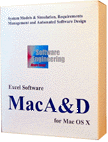
|

|
- Data Flow Diagrams
- System analysts use process models (i.e. data flow diagrams, DFDs) to show information flow and processing in a system. The model usually starts with a context diagram showing the system bubble surrounded by the external environment identified by external entities. Data flows bring information to and from the system process.
A process can explode to a child diagram that presents its details using data stores, data flows and sub processes. The diagram leveling process allows complex systems to be easily partitioned into a stack of simple diagrams with rigorous balancing of information between levels. Information structures are defined in an associated data dictionary.
A process can explode to a child diagram in the same or a different DFD document. Each developer in a team can work independently on a DFD document that contains diagrams for a portion of the entire system.
- Structure Charts
- Structure charts show module structure and calling relationships. In a multi-threaded system, each task (thread of execution) is represented as a structure chart. Large structure charts are leveled into a stack of connected diagrams.
- State Models
- State models include diagrams and tables that show the significant states in a system, events that cause transitions between states and the actions that result.
- Task Diagrams
- Task diagrams show threads of execution and the real-time operating system services like queues, event flags and semaphores that connect them in a multi-tasking environment. Each task can be associated with its structure chart representation.
- Structure Charts